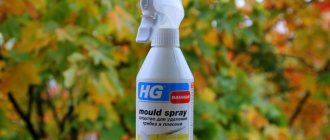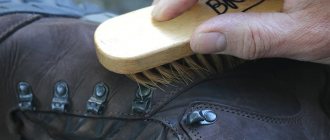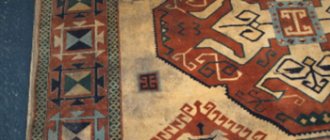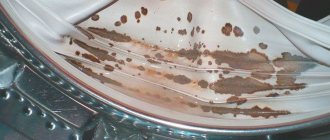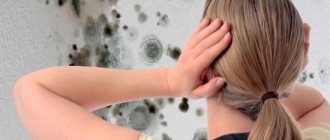The appearance of mold in an apartment is not only an unpleasant sight, but also a phenomenon dangerous to human health.
Black mold is especially dangerous. There is only one reason for the appearance - dampness. This fungus spreads spores indoors, which, spreading through the air, provoke various diseases of the respiratory system.
How to remove mold? Getting rid of mold is not easy, but it is still possible with your own hands, without the involvement of specialists.
Why should you be afraid of mold?
Mold is a special type of fungus that reproduces using small spores that are invisible to the naked eye. As scary as it sounds, every person has similar microparticles of mold in their home. However, their number is often negligible and they cannot continue their development, especially when there are no suitable conditions.
At the moment, there are several different types of mold, but the most common in the apartment remain:
- Black mold. The most frequent guest of the bathroom, walls, ceiling and wallpaper. When characteristic dark spots appear on these surfaces, the first thing you need to think about is a fungal infection.
- Blue mold. Relevant when it comes to wooden objects, floors or other parts of the apartment. It affects structures made of boards and the like.
- White mold. Occurs on flowerpots after too intense watering.
There are other types of fungus, however, they are much less common in a person’s home and pose virtually no threat.
As for black mold, it remains quite dangerous. An apartment in which the growth of such “thickets” progresses automatically turns into a breeding ground for allergens.
The main threat posed by such a fungal infection at home remains spores. These microparticles of mold can cause powerful allergic reactions leading to serious health problems.
Regular stay in a house with fungus is fraught with the progression of pulmonary diseases, the most dangerous of which remains bronchial asthma. Against this background, it develops especially often in young children, whose respiratory system is not yet fully formed.
One way or another, the fact remains obvious that when the slightest speck of mold appears on any part of the house, be it a wall or the surface of a sofa, you immediately need to start fighting it. Otherwise, residents will experience progressive deterioration in their health with the development of serious diseases.
Preparation
Wear long sleeves, old pants or trousers, and cover your hands with gloves. If you have safety glasses or a mask, be sure to wear them to avoid inhaling mold spores. It is very dangerous. You can also use a respirator.
Many people have these means of protection because the coronavirus pandemic is not over yet. Furniture affected by mold should be taken outside into the sun. Direct sunlight has a detrimental effect on mold and prevents its spread.
Now you need to sweep away the top layer of mold with a broom or broom. Remove all stains visible to the naked eye. Try not to touch clean areas of furniture, because you may accidentally introduce spores there too.
Why does mold appear in an apartment?
To answer the question: “How to deal with mold in an apartment?”, you need to understand why it appears in the first place. It is a well-known fact that fungus loves damp and poorly ventilated spaces. Therefore, in areas of the home where there is a regular accumulation of excess liquid and insufficient ventilation, it will certainly begin to grow.
The main reason for the appearance of mold in an apartment is poor ventilation
The reasons for this situation may be:
- Freezing of walls with moisture retention in the brickwork.
- Leaking water pipe in the wall.
- Problem with the roof (relevant for owners of private houses and apartments on the top floors).
- General poor waterproofing of the room.
- Lack of heating.
- Plumbing breakdowns.
All these factors can lead to the progression of fungus in an apartment or house.
If we talk separately about mold on furniture, then the wood from which it is made can be infected with spores and through no fault of the owner.
The most common causes of fungal growth on fittings are the following:
- Violations of production technology. In theory, all wood that is used to make furniture is pre-treated with special solutions and antiseptics to reduce the risk of fungal growth to zero. If this stage was ignored, and mold spores were introduced into the structure before its implementation, then the owners will very soon be looking for a good remedy for mold on wood.
- Introducing spores from outbreaks in the apartment. If there are areas of fungal infection in the room, it can spread to furniture surfaces that have not been properly treated.
- Constant exposure to moisture. If water regularly gets on the fittings, it quickly begins to deteriorate, and mold can begin to grow progressively.
Knowing why a fungal infection occurs, it is much easier to fight it. To effectively overcome the problem, it is necessary to exclude the influence of the above factors.
Prevention of occurrence
It is much easier to prevent a mold problem than to spend a long time trying to get rid of it. Among the most common preventive measures, several are worth noting:
An antimicrobial spray will help prevent fungal growths.
An alternative is to purchase anti-mold paint.- Shower curtains and towels should be carefully straightened after use.
- Problems with leaking plumbing should be addressed immediately. To prevent moisture from accumulating in cracks under the floor.
How to get rid of mold in an apartment for sure?
So, we managed to figure out the main reasons for the spread of the problem. Now it’s a matter of choosing a method to eliminate it. It is important to first assess the extent of the damage. If mold covers small localized areas somewhere on the wall or in a corner under the ceiling, then any home owner can easily cope with this task.
Is it possible to get rid of mold forever?
However, when we are talking about the extensive spread of “thickets” over the surface of the entire wall, involving a large amount of furniture in the process, it is often necessary to turn to specialized teams for help.
However, in the fight against mold, a certain sequence of measures must be followed.
Conventionally, we can distinguish three stages of such cleaning of an apartment or house:
- Elimination of the cause of the fungus. If the problem is in the pipes, you should call a plumber. When the roof leaks, contact the appropriate utility services and the like. The main thing is to eliminate the influence of high humidity and insufficient air circulation.
- Actually mechanical and chemical cleaning of the premises. A set of methods aimed at completely destroying the area affected by the fungus.
- Preventive measures that will prevent the recurrence of mold on furniture, walls and the like.
If everything is clear about the question of eliminating factors leading to the progression of fungal growth, then you need to get acquainted with the methods of getting rid of “thickets” in more detail, especially when it comes to wooden surfaces and furniture.
Appeal to professionals
Turning to professionals is an expensive procedure, but it will be 100% effective and will rid your home of the harmful effects of pathogenic microorganisms. This is a whole process that requires preparation. It is carried out according to the algorithm:
- identifying the cause;
- restriction of all furniture and structures from contact with other things;
- ensuring optimal climatic conditions for work;
- complete destruction of mechanical fungus;
- chemical treatment;
- drying and restoration measures, if required;
- coating with antiseptic and varnish.
Of course, the scope of work varies depending on the conditions (outdoors or indoors, the size of the surface being treated), and the type of formation.
How to destroy mold on furniture?
If a fungal infection first appears on the walls of a room, then there is a high chance that it will soon spread to the fittings. How to get rid of mold on furniture? This is what interests many owners of wooden interior elements.
Thorough cleaning and treatment of furniture with special products will help get rid of fungus
It’s worth starting with the fact that the main idea of such a fight is, first of all, to eliminate high humidity and lack of ventilation in the room. In the process of plastering and puttying work in a house or apartment, one must not forget about waterproofing the room.
For this, a special primer against mold and mildew is additionally used. It already contains a ready-made antiseptic and fungicide that prevents the progression of the growth of new colonies.
Then it's up to specialized tools. At the moment, there are quite a large number of ready-made factory-made antiseptics for wood processing. However, it is often enough to use folk remedies that people used to save themselves for centuries before the advent of powerful modern drugs.
Kinds
The type of mold determines the choice of method that will help you effectively deal with it forever.
Black
Black mold is the most active and fastest growing of all. It usually destroys the surface quickly. There are several strains that cannot be distinguished from each other without special research.
It is very dangerous for humans, as if it enters the body it causes poisoning and allergies. Fighting black mold is quite difficult - it is not susceptible to most folk and chemical preparations.
Xin
Blue is not so dangerous for the human body, but it causes destruction of structures. Affects fresh and old wood, leading to its rotting. Particularly dangerous for load-bearing structures.
Putrefactive fungus
Putrefactive fungus spreads under conditions of high humidity in the room and the presence of external sources of moisture. Antiseptics and home methods can cope with it.
White
White mold affects not only furniture, but also food. It is easy to deal with, since it is not resistant to aggressive drugs. It does not pose any significant danger to the body.
Effective folk methods of fighting fungus
At a time when people did not have access to today’s fashionable products, they used improvised and industrial liquids.
The most popular and truly effective remain:
- Ordinary table vinegar. To achieve the desired effect, you need to moisten the wooden surface with it. Next, use a metal or stiff brush to treat the affected area. Wash away any remaining contaminated wood. Re-treat the area with a spray bottle. Let dry (about an hour) and wipe again. In this simple way you can thoroughly clean almost any furniture.
- Hydrogen peroxide. Another simple and reliable home method for removing mold. It is necessary to apply a 3% solution of the drug to the affected area of the tree. Leave it for 10 minutes to absorb. Then use a brush to clean the “disaster” area. Wipe with a damp cloth and then with a dry cloth for final cleaning.
- Baking soda. The peculiarity of its effect remains the ability to absorb the smell of mold. This is especially useful when it comes to combating mold on your sofa or bed. To achieve the desired result, you need to moisten a rag in water and apply a little soda to it. Next, thoroughly wipe the affected area of the tree. Then rinse everything off and dry.
- Tea tree oil. A rather original method for cleaning furniture from mold. It has a powerful but gentle effect. In addition, it does not require a lot of the corresponding product to achieve the effect. For 1 liter of water you need 1 teaspoon of oil. This mixture is poured into a spray bottle, sprayed over the surface, cleaned with a stiff brush and wiped dry.
Another good remedy that will help solve the problem of how to remove mold from wooden surfaces is creosote. This is a specific yellowish oily liquid that is used to treat ship sleepers.
It is rarely used at home, however, it is perfect for cleaning technical or utility rooms. Due to its pungent odor and toxicity, working with it should only be done in a respirator and rubber gloves.
It is enough to first mechanically clean the wood and apply several layers of creosote. They cannot treat furniture with it.
Which fungal remedy should I choose?
Let's move on to the main question: what is the best remedy for mold on the walls to prevent it from appearing again over time? Here is a list of the most effective drugs, each of them copes well with all types of fungus. Your task is to choose exactly the product that is right for you.
Bleach. Will help clean mold from tiles or glass, but not suitable for all porous materials
It is toxic, so it must be used with extreme caution. You need to dilute the bleach with water in a ratio of 1/10
It is better to apply with a wide brush or spray. Vinegar. Helps fight against mold on all surfaces and materials. It has a pungent odor and can damage furniture or wallpaper, affecting the color. Spray vinegar or apply it to the surface with a rag. After a week, repeat the procedure for prevention.
Lemon juice or citric acid. It has the same properties as vinegar, but besides that, it smells nice. Any materials can be processed, and tiles are washed most efficiently. For a glass of water, use 1 tablespoon of juice or acid. After this, the surfaces are completely processed.
- Hydrogen peroxide. The optimal remedy, since removing mold using this method is convenient and safe. Peroxide is applied to any surfaces except actively painted ones (the color may fade). Use a rag or spray. After a week, repeat the procedure again.
- Baking soda. Removing mold with baking soda is effective and safe. Dissolve a tablespoon of baking soda in a glass of water. Spray or rub over the infected area. After an hour, wipe the wall with water again to avoid streaks.
Prepare an interesting and very effective solution. Take 100 ml of water, 50 ml of vinegar, 50 ml of hydrogen peroxide, 25 ml of boric acid. Combine these components in a container and heat over a fire to 50-70 degrees. Spray or rub this product over the infected area. Repeat the manipulation once every couple of days for the purpose of prevention. This method is the most effective for cleaning tile joints.
Chemical antiseptics to rid an apartment of mold
In addition to proven folk remedies, the modern building materials market offers its consumers a huge selection of affordable and high-quality factory-made fungicides that do an excellent job of killing fungus and mold on almost any surface and material, including wood.
The following remain the most popular:
- Alpa "Fongifluid" . One of the most universal antiseptics, which has a wide spectrum of action against bacteria, mold and mosses of various types. Ideal for processing stone and wooden surfaces. Available in convenient packaging and remains affordable.
- OLYMP Stop-Mold . Another option for a high-quality fungicide that works great against mold. Suitable for processing wood, as well as regular walls or even wallpaper (can be added to the appropriate adhesive). Available in 5 liter containers. Remains safe for humans.
- An excellent spray with a powerful fungicidal effect. Thanks to its convenient spray nozzle, it is ideal for treating furniture and small wooden surfaces.
The above products must be used according to the instructions for antiseptics. Basically, it does not involve anything complicated, however, sometimes it is worth consulting first with the salesperson in the store.
Tools for fixing the problem yourself
After favorable conditions for the active development of fungus have been eliminated, measures can be taken to eliminate already developed mold on the tree. For this you can use chemicals. There is a list of solutions that can remove mold from wood. They are sold in construction and hardware stores. The most common means are:
- Dali - can be used for application on wooden, tiled, painted and concrete surfaces.
- Biotol spray - can be used to treat cellars, basements, attics and facades.
- Stop-Mold is a concentrated product that should be used to treat the areas most susceptible to fungal infections.
- Alpa - antifungal solution intended for interior work.
Before using such solutions, visible areas of fungus must be eliminated. After removing such lesions, it is necessary to rinse these areas with clean water. An antiseptic against fungus should be used only after the surface has dried. Usually it is necessary to apply the preparation in several layers - only then will it be possible to destroy the mold that is located in the thickness of the wood.
https://youtube.com/watch?v=MOUMM8kC_G0
Precautionary measures
Most of the above remedies and professional preparations remain safe for humans. In any case, this does not mean that you can ignore basic safety rules. You should always wear a respirator and rubber gloves. Whether it's simple vinegar or a serious chemical, it never hurts to be extra careful.
It is also worth remembering that the treatment of the room or furniture must be carried out in a well-ventilated area to speed up the drying of the solutions. Accordingly, at the time of cleaning the room or its interior, no strangers should be in it to prevent exposure to appropriate anti-fungal agents.
The fact remains obvious that it is quite possible to eliminate mold in an apartment or on furniture on your own. The main thing is to choose the most optimal product and use it according to the instructions. Fungal infection should be identified as quickly as possible. Timely destruction of dark “thickets” remains the key to the health of the residents of a house or apartment.
